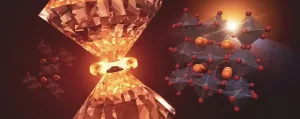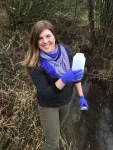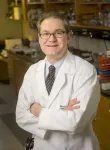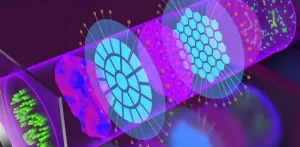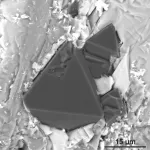Researchers develop new graphene nanochannel water filters
2021-01-21
(Press-News.org) PROVIDENCE, R.I. [Brown University] -- When sheets of two-dimensional nanomaterials like graphene are stacked on top of each other, tiny gaps form between the sheets that have a wide variety of potential uses. In research published in the journal Nature Communications, a team of Brown University researchers has found a way to orient those gaps, called nanochannels, in a way that makes them more useful for filtering water and other liquids of nanoscale contaminants.
"In the last decade, a whole field has sprung up to study these spaces that form between 2-D nanomaterials," said Robert Hurt, a professor in Brown's School of Engineering and coauthor of the research. "You can grow things in there, you can store things in there, and there's this emerging field of nanofluidics where you're using those channels to filter out some molecules while letting others go through."
There's a problem, however, with using these nanochannels for filtration, and it has to do with the way those channels are oriented. Like a notebook made from stacked sheets of paper, graphene stacks are thin in the vertical direction compared to their horizontal length and width. That means that the channels between the sheets are likewise oriented horizontally. That's not ideal for filtration, because liquid has to travel a relatively long way to get from one end of a channel to the other. It would be better if the channels were perpendicular to the orientation of the sheets. In that case, liquid would only need to traverse the relatively thin vertical height of the stack rather than the much longer length and width.
But until now, Hurt says, no one had come up with a good way to make vertically oriented graphene nanochannels. That is until Muchun Liu, a former postdoctoral researcher in Hurt's lab, figured out a novel way to do it.
Liu's method involves stacking graphene sheets on an elastic substrate, which is placed under tension to stretch it out. After the sheets are deposited, the tension on the substrate is released, which allows it to contract. When that happens, the graphene assemblage on top wrinkles into sharp peaks and valleys.
"When you start wrinkling the graphene, you're tilting the sheets and the channels out of plane," said Liu, who is now a researcher at Massachusetts Institute of Technology. "If you wrinkle it a lot, the channels end up being aligned almost vertically."
Once the channels are nearly vertical, the assemblage is encased in epoxy, and the tops and bottoms are then trimmed away, which opens the channels all the way through the material. The researchers have dubbed the assemblages VAGMEs (vertically aligned graphene membranes).
"What we end up with is a membrane with these short and very narrow channels through which only very small molecules can pass," Hurt said. "So, for example, water can pass through, but organic contaminants or some metal ions would be too large to go through. So you could filter those out."
Proof-of-concept testing demonstrated that water vapor could pass easily through a VAGME, while hexane -- a larger organic molecule -- was filtered out. The researchers plan to continue developing the technology, with an eye toward potential industrial or household filtering applications.
INFORMATION:
The research was supported by the National Institute of Environmental Health Sciences Superfund Research Program (P42 ES013660).
[Attachments] See images for this press release:
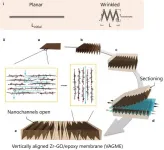
ELSE PRESS RELEASES FROM THIS DATE:
2021-01-21
TROY, N.Y. -- Warnings about misinformation are now regularly posted on Twitter, Facebook, and other social media platforms, but not all of these cautions are created equal. New research from Rensselaer Polytechnic Institute shows that artificial intelligence can help form accurate news assessments -- but only when a news story is first emerging.
These findings were recently published in Computers in Human Behavior Reports by an interdisciplinary team of Rensselaer researchers. They found that AI-driven interventions are generally ineffective when used to flag issues with stories on frequently covered ...
2021-01-21
Among the materials known as perovskites, one of the most exciting is a material that can convert sunlight to electricity as efficiently as today's commercial silicon solar cells and has the potential for being much cheaper and easier to manufacture.
There's just one problem: Of the four possible atomic configurations, or phases, this material can take, three are efficient but unstable at room temperature and in ordinary environments, and they quickly revert to the fourth phase, which is completely useless for solar applications.
Now scientists at Stanford ...
2021-01-21
Delivering a minor electric shock into a stream to reveal any fish lurking nearby may be the gold standard for detecting fish populations, but it's not much fun for the trout.
Scientists at Oregon State University have found that sampling stream water for evidence of the presence of various species using environmental DNA, known as eDNA, can be more accurate than electrofishing, without disrupting the fish.
"It's revolutionizing the way we do fish ecology work," said Brooke Penaluna, a research fish biologist with the U.S. Department of Agriculture Forest Service who also has an appointment in OSU's Department ...
2021-01-21
If you believe you are capable of becoming the healthy, engaged person you want to be in old age, you are much more likely to experience that outcome, a recent Oregon State University study shows.
"How we think about who we're going to be in old age is very predictive of exactly how we will be," said Shelbie Turner, a doctoral student in OSU's College of Public Health and Human Sciences and co-author on the study.
Previous studies on aging have found that how people thought about themselves at age 50 predicted a wide range of future health outcomes up to 40 years later -- cardiovascular events, memory, balance, will to live, hospitalizations; even mortality.
"Previous ...
2021-01-21
BIRMINGHAM, Ala. - A 72-year-old woman was hospitalized with severe COVID-19 disease, 33 days after the onset of symptoms. She was suffering a prolonged deteriorating illness, with severe pneumonia and a high risk of death, and she was unable to mount her own immune defense against the SARS-CoV-2 virus because of chronic lymphocytic leukemia, which compromises normal immunoglobulin production.
But when physicians at the University of Alabama at Birmingham recommended a single intravenous infusion of convalescent blood plasma from her son-in-law -- who had recovered from COVID-19 disease ...
2021-01-21
Microscopy is the workhorse of contemporary life science research, enabling morphological and chemical inspection of living tissue with ever-increasing spatial and temporal resolution. Even though modern microscopes are genuine marvels of engineering, minute deviations from ideal imaging conditions will still lead to optical aberrations that rapidly degrade imaging quality. A mismatch between the refractive indices of the sample and its immersion medium, deviations in the thickness of sample holders or cover glasses, the effects of aging on the instrument--such deviations ...
2021-01-21
Contemporary robots can move quickly. "The motors are fast, and they're powerful," says Sabrina Neuman.
Yet in complex situations, like interactions with people, robots often don't move quickly. "The hang up is what's going on in the robot's head," she adds.
Perceiving stimuli and calculating a response takes a "boatload of computation," which limits reaction time, says Neuman, who recently graduated with a PhD from the MIT Computer Science and Artificial Intelligence Laboratory (CSAIL). Neuman has found a way to fight this mismatch between a robot's "mind" and body. The method, called robomorphic computing, uses a robot's physical layout and intended applications ...
2021-01-21
BOSTON - Regular aspirin use has clear benefits in reducing colorectal cancer incidence among middle-aged adults, but also comes with some risk, such as gastrointestinal bleeding. And when should adults start taking regular aspirin and for how long?
There is substantial evidence that a daily aspirin can reduce risk of colorectal cancer in adults up to age 70. But until now there was little evidence about whether older adults should start taking aspirin.
A team of scientists set out to study this question. They were led by Andrew T. Chan MD, MPH, a gastroenterologist and chief of the Clinical and Translational Epidemiology Unit at ...
2021-01-21
Diamond, like graphite, is a special form of carbon. Its cubic crystal structure and its strong chemical bonds give it its unique hardness. For thousands of years, it has also been sought after as both a tool and as a thing of beauty. Only in the 1950s did it become possible to produce diamonds artificially for the first time.
Most natural diamonds form in the Earth's mantle at depths of at least 150 kilometres, where temperatures in excess of 1500 degrees Celsius and enormously high pressures of several gigapascals prevail - more than 10.000 times that of a well-inflated bicycle tyre. There are different theories for the exact mechanisms ...
2021-01-21
The liquid electrolytes in flow batteries provide a bridge to help carry electrons into electrodes, and that changes how chemical engineers think about efficiency.
The way to boost electron transfer in grid-scale batteries is different than researchers had believed, a new study from the University of Michigan has shown.
The findings are a step toward being able to store renewable energy more efficiently.
As governments and utilities around the world roll out intermittent renewable energy sources such as wind and solar, we remain reliant on coal, natural gas and nuclear power plants to provide energy when the wind isn't blowing and the sun isn't shining. Grid-scale "flow" batteries are one proposed solution, storing energy for later use. But because they aren't very efficient, ...
LAST 30 PRESS RELEASES:
[Press-News.org] Researchers develop new graphene nanochannel water filters

